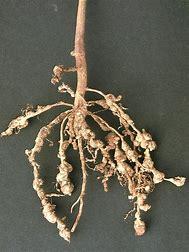We need a solution to the problem of getting rid of root-knot nematodes. We’ve tried solarizing our raised planter beds, but it doesn’t seem to last long, if at all.

We’re sorry to hear about the issues with nematodes in your raised beds. Nematodes are nearly impossible to completely get rid of, but control is possible through a combination of techniques. You do not mention if your raised beds are completely raised (i.e. not in contact with the soil) or in contact with soil but somewhat raised. If your raised beds are not in contact with the soil a drastic (and expensive!) option would be to replace all the soil with nematode free soil purchased at a garden center. There are other techniques to reduce the nematode population, however.
Nematodes need host roots of susceptible plants to survive. For soil solarization to be effective, as many roots and root pieces as possible need to be removed from the soil. The soil temperature must be raised to 140 degrees or higher down through the depth of the nematodes. It is challenging to heat the soil below several inches to this temperature. The soil should be moistened and then the polyethylene sheeting must be left on for 6 to 12 weeks, normally. Should this succeed, any tools used elsewhere with even a small amount of soil may re-introduce the nematodes to the raised beds, or if the raised bed is touching native soil at any point the nematodes may migrate. Solarization can certainly reduce the prevalence, but rarely completely rids soil of nematodes.
There are additional techniques to reduce the prevalence of nematodes and allow for a successful vegetable garden. One of the easiest is to select nematode resistant plant varieties. In the references below are links to the UH CTAHR seed order form (limited seed selection available) which shows the varieties available for order that are nematode resistant. There is also a link for Hawaii Seed Grower’s network; searching on that site for “nematode” will return the seeds available through them that are known to be nematode resistant. Links from Clemson and NC State discuss techniques and a larger selection of varieties that are resistant but would have to be ordered, most likely, through a reputable online seed vendor.
Crop rotation helps, also. If some raised beds are planted with nematode resistant varieties, the next set of plantings can be less resistant, while resistant varieties are planted in the bed that was previously planted with non-resistant plants. All plants and plant roots should be pulled immediately after final harvest. If you can leave a garden bed fallow, you can repeatedly till every 10 days or so to bring most nematodes to the surface where the sun can kill them. Another technique is to plant a mass of marigolds (no more than 7 inches apart throughout a bed and allow them to grow for at least 2 months. The marigolds then should be tilled under, and nematode sensitive plants may be planted.
There are no pesticidal controls available in Hawaii for nematodes as the only controls are extremely toxic. You may see biological/organic controls advertised but any improvement from using them seems to be just because they provide nutritional supplements to the plants, not because nematodes have been controlled.
We are sorry not to have better news, but crop rotation, soil solarization, and selecting plants and plant varieties which are least susceptible should lead to better results with consistent effort. Best of luck with control and feel free to contact us with follow-up questions.
References:
General discussions of nematodes and disease-resistant varieties:
https://www.ctahr.hawaii.edu/oc/freepubs/pdf/PD-15.pdf
https://hgic.clemson.edu/factsheet/root-knot-nematodes-in-the-vegetable-garden/
https://content.ces.ncsu.edu/control-of-root-knot-nematodes-in-the-home-vegetable-garden
Hawaii specific sources for nematode resistant seeds:
https://www.ctahr.hawaii.edu/seed/Downloads/New%202020%20Seed%20Order%20Form.pdf
https://www.hawaiiseedgrowersnetwork.com/
TF-RC-6/25/2024



